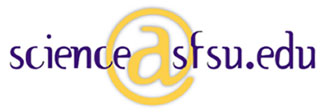
College of Science & Engineering Alumni Newsletter
Fall 1997

College of Science & Engineering Alumni Newsletter
Fall 1997
A team of scientists led by SFSU professor of biology Thomas B. Smith, an internationally recognized evolutionary biologist specializing in the tropics, reports in the journal that ecotones may be integral to generating biodiversity in tropical rain forests.
Conserving these ecotones
may be critical to preserving the processes that maintain diversity in
rain forests, says Smith. "Ecotones are dynamic environments that have
typically been overlooked," he explains. "The general belief is that if
we preserve rain forests we’re also preserving the processes that create
biodiversity. But our findings suggest that the engines generating new
species and increased biodiversity may lie in the unprotected ecotones
at the forest periphery."
Responding to Need: Computer Science and the Cisco Networking Academy. With the tremendous growth in the Internet, the demand for skilled computer networking specialists in industry, education, and government is greatly outstripping the supply of trained professionals. Cisco Systems, the world's largest networking company, estimates that nationwide there are 190,000 unfilled positions in networking assistance. Cisco has taken the bull by the horns and become directly involved in the delivery of training in network support. This year, Cisco created the Cisco Networking Academy (CNA) as their vehicle for delivering this curriculum.
The plan for CNA is to create hundreds of Regional Academies (RA), each supervising ten Local Academies (LA). Through SFSUnet, our campus community electronic communication project, we have established San Francisco State as one of the first Regional Academies. This year, working with the College of Education, SFSUnet has brought the first CNA courses to the University.
Representatives of the
Local Academies, mostly San Francisco Unified School District high schools,
have come to campus to enroll in the initial training courses. These representatives
will return to their schools and begin teaching high school students the
basics of networking next Spring. The long range plans for CNA include
a curriculum to be offered at the university level as well. "As a department,
we look forward to building on our relationship with Cisco," said Gerald
Eisman, Chair of the Computer Science Department at SFSU.
Attention Small Manufacturers! Waste Not, Want Not. The Industrial Assessment Center (IAC) is a unique industrial program in the School of Engineering. Funded by a contract from the U. S. Department of Energy, and one of only two such programs in California, the IAC employs mechanical, electrical, and civil engineering students to perform energy and waste assessments on small- and medium-sized manufacturing facilities in the San Francisco Bay Area. The benefits go both ways: giving hands-on experience to students and making manufacturing companies more efficient and cost-effective. Best of all, the IAC does not charge its clients.
Under the leadership of engineering faculty Ahmad Ganji, Shy-Shenq Liou, and Ron Trauner, student teams visit manufacturing facilities, identify patterns of energy consumption and waste generation, and produce an engineering report, which includes an executive summary, an accounting of the energy used and waste generated at the site, followed by conservation and minimization recommendations. "Between forty and fifty per cent of our recommendations are implemented, representing substantial savings for the manufacturer," explained Ron Trauner.
In order to receive this no-cost service, firms must be engaged in manufacturing, have fewer than 500 employees, have an annual energy consumption bill of less than $1.7 million, have no in-house energy expert, and be located within 150 miles of San Francisco.
SFSU’s Industrial Assessment
Center performs energy and waste audits on all sorts of companies, from
chocolate factories to computer chip and fiberglass manufacturers. Contact
Ron Trauner at 415.338.6218 to set up an assessment for your business.
Loma Prieta May Have Delayed Large Bay Area Quake. Researchers report in the June 27 issue of Science that the 1989 Loma Prieta earthquake may have acted to delay large earthquakes along the Hayward fault by 6 to 7 years.
The probability of a magnitude 7 or larger earthquake in the next 30 years on the Hayward fault is 45%, the researchers report in their paper, and is considered to be the most hazardous fault zone in the San Francisco Bay region.
Jon Galehouse, professor
emeritus of geosciences, and James Lienkaemper, USGS, have found that the
Loma Prieta earthquake relaxed the stress on the Hayward fault, slowing
the creep, or movement, along the fault-line. While this may have served
to delay large earthquakes by a few years, it has negligible effects on
reducing the build-up of the "crustal strain" that leads to major earthquakes,
according to the researchers.
Bizarre Deep-sea Creature Discovered Living on Methane Ice. A team of university scientists, including Dr. Alissa Arp, Director of SFSU’s Romberg Tiburon Center for Environmental Studies, and SFSU researcher Dr. David Julian, have discovered a colony of what may be a new species of centipede-like worm living within mounds of toxic methane ice in the Gulf of Mexico.
Although scientists have
hypothesized that bacteria might colonize these ocean-floor ice mounds,
called gas hydrates, this is the first time animals have been found living
within the mounds. The findings raise speculation that the worms may be
a new species with a pervasive and as yet unknown influence on these energy-rich
deposits.